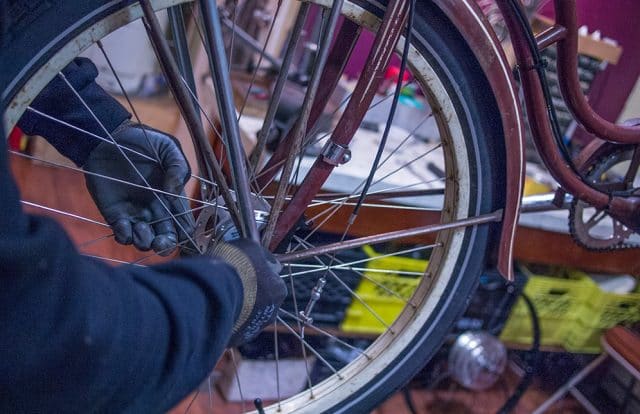7 Things You Should Never Do to Your Bike
Follow these care-and-keeping rules if you want your bike to last.
Follow these care-and-keeping rules if you want your bike to last. – By Robert Annis

For every warning a bike manufacturer includes in a user manual for a new ride, there’s a cyclist who doesn’t follow directions. However, some rules aren’t made to be broken. Here are seven things you should never, ever do to your bike, if you want it to last.
Put it away dirty
When you finish a ride, particularly in wet or sloppy conditions, be sure to at least wipe down the frame and give the drivetrain a quick cleaning. You don’t want the dirt and grime to calcify in your components, mucking up everything and costing you valuable watts, says Andy Williamson, executive director of IMBA Great Lakes Region. Williamson keeps a gallon-size weed sprayer in his car to quickly and easily wash his bike after dirty rides. If you don’t have a similar sprayer, use a bucket and warm soapy water when you get home. Don’t ever take your mountain bike to the self-service car wash, as the high-pressure spray can damage bearings inside your hubs. By keeping your rig clean, you can also more easily monitor the wear of your tires, chains, and cables, says Michael Kubancsek, director of cycling operations for Marian University.
Ride it with worn components
Speaking of which, if your brakes are worn or your cables have frayed, replace them sooner rather than later, Kubancsek says. Even if you’re planning to buy a new bike this season, you don’t want the shifter cable to finally give out when you’re two hours from home.
Do your own maintenance without the proper tools or training
Every cyclist has made a costly mistake while trying to fix something beyond their ken. If you want to learn how to make a particular repair, first make sure a minor mistake won’t lead to a major issue. For instance, occasionally overlubing your chain, which can suck dirt and grit into your drivetrain, won’t cause major problems—but over-tightening bolts on carbonfibre frames can be catastrophic, as it’s all too easy to crush the material.
Keep it outside overnight, or unlocked
Bicycle theft is on the rise in South Africa. You might need to run into the convenience store for just a moment, but that’s all it takes for someone to throw your bike into the back of a truck or just pedal away. Taking an Uber home in cycling clothes is never fun. Even if your bike is securely locked outside, don’t leave it in the elements overnight. Rain, snow, and morning condensation can cause your bike or its components to rust.
Hardware-store storage hooks only cost a few bucks and make storing bikes in the garage a snap. Don’t have a garage? Splurge on a nice wall-mounted bike rack and store your bike inside your home like the work of art it is.
Lay it down on the drive side
If you’re stopping for a mid-ride break and can’t find anything to lean your bike against, never lay it on the ground drive-side down, lest your derailleurs misalign. If you catch a riding buddy doing this, threaten to install a kickstand if it happens again.
Hang your bike upside down (if you’re running hydraulic disc brakes)
Feel free to ignore this if your bike features rim brakes, but if you’re running Shimano XT, SRAM Guide, or another type of hydraulic brakes, avoid storing your bike upside down in your garage. When upside down, air goes to the caliper, and you get squishy brakes until the air goes back to the top in the reservoir—something that will often require a brake bleed to correct.
“Bleeding hydro brakes can be like a chemistry lab gone wrong,” said Chris Wiggins, owner of A1 Cyclery. If you’re unsure of how to do it yourself, take your bike to your local shop and ask to watch the process. You’ll know your brakes have been professionally serviced, and you’ll learn more about how to care for them.
Over- or under-inflate your tyres
Check your tyre pressure before every ride. Low air pressure can easily lead to a pinch flat and prematurely wear out your tire rubber. But don’t pump to the maximum amount—often 8-9bar for road tyres and 4 for mountain-bike tyres—as there’s rarely any need to go that high. For road tires, most shop mechanics recommend running 70 to 90 per cent of the maximum bar based on riding conditions and your weight. (Heavier riders should err on the side of a higher tyre pressure.) Mountain bike tyres are much more variable, with some tyres pressures dipping into the teens, based on the conditions we just mentioned. If the road or trail you’re riding is dry and in great shape, aim for the upper end of the scale, which will allow you to ride both faster and smoother. But if conditions are wet or muddy, drop your pressure a few pounds, which will give you more of a contact patch with the ground and more stability.
READ MORE ON: bike advice maintenance MTB road

